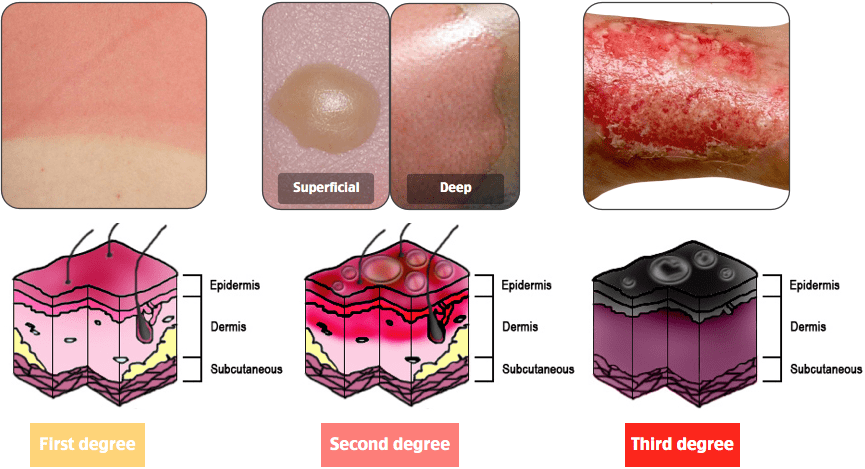

deep dermal or partial thickness burn – where the epidermis and the dermis are damaged this type of burn makes your skin turn red and blotchy your skin may be dry or moist and become swollen and blistered, and it may be very painful or painless.superficial dermal burn – where the epidermis and part of the dermis are damaged your skin will be pale pink and painful, and there may be small blisters.superficial epidermal burn – where the epidermis is damaged your skin will be red, slightly swollen and painful, but not blistered.There are 4 main types of burn, which tend to have a different appearance and different symptoms:

the subcutaneous fat, or subcutis – the deeper layer of fat and tissue.the dermis – the layer of tissue just beneath, which contains blood capillaries, nerve endings, sweat glands and hair follicles.the epidermis – the outer layer of skin.The size and depth of the burn will be assessed, and the affected area cleaned before a dressing is applied. In severe cases, skin graft surgery may be recommended.īurns are assessed by how seriously your skin is damaged and which layers of skin are affected. People at greater risk from the effects of burns, such as children under 10 years old, should also get medical attention after a burn or scald. Some symptoms may be delayed and can include: If someone has breathed in smoke or fumes, they should also get medical attention. burns on the face, neck, hands, feet, any joints or genitals.burns that cause white or charred skin – any size.large or deep burns – any burn bigger than the injured person's hand.You should go to a hospital A&E department for:
#3RD DEGREE BURN BLISTER PROFESSIONAL#
More serious burns require professional medical attention. When to get medical attentionĭepending on how serious a burn is, it may be possible to treat it at home.įor minor burns, keep the burn clean and do not burst any blisters that form. Read more about treating burns and scalds.

make sure the person keeps warm by using a blanket, for example, but take care not to rub it against the burnt area.cool the burn with cool or lukewarm running water for 20 to 30 minutes – do not use ice, iced water, or any creams or greasy substances like butter.remove any clothing or jewellery that's near the burnt area of skin, including babies' nappies, but do not move anything that's stuck to the skin.immediately get the person away from the heat source to stop the burning.To treat a burn, follow the first aid advice below: Even a very serious burn may be relatively painless. This article has been viewed 390,029 times.The amount of pain you feel is not always related to how serious the burn is.

In this case, several readers have written to tell us that this article was helpful to them, earning it our reader-approved status. WikiHow marks an article as reader-approved once it receives enough positive feedback. There are 11 references cited in this article, which can be found at the bottom of the page. Tareen then completed a procedural fellowship which focused on dermatologic surgery, laser, and cosmetic dermatology. While a dermatology resident at Columbia University in New York City, she won the Conrad Stritzler award of the New York Dermatologic Society and was published in The New England Journal of Medicine. Tareen completed medical school at the University of Michigan in Ann Arbor, where she was inducted into the prestigious Alpha Omega Alpha honor society. Mohiba Tareen is a board certified Dermatologist and the founder of Tareen Dermatology located in Roseville, Maplewood and Faribault, Minnesota. This article was co-authored by Mohiba Tareen, MD.


 0 kommentar(er)
0 kommentar(er)
